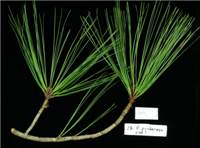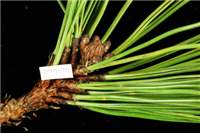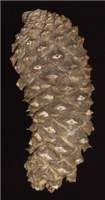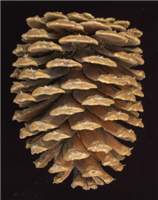Name
Pinus ponderosa Douglas ex C.Lawson, Agric. Man.: 354 (1836).[Ponderosa pine, Western yellow pine]
Description
Habit: A tall tree growing up to 70 m tall in its native habitat. When young the tree is narrow and conic. Although the shape becomes more variable with age, it usually retains a distinctive spire-like habit, with a narrow crown and straight upright stem, until very old. The crown may vary considerably in density and colour but the ‘chimney-brush’ set of the foliage, which is often densely tufted near the end of the branchlets, is usually distinctive. Old, open-grown trees often have a few big lower branches which give them an irregular crown. Severe exposure may make the crown asymmetric but usually without causing much lean or stem sweep. Until the trees are quite old (around 25-30 m tall) the lower bole generally has a pronounced taper, but older trees develop cylindrical butts.
Bark: At first pale purplish grey, later becoming reddish or brownish grey. The bark is thick in quite small trees, with diffuse, fairly finely grained fissures and irregular flakes. As trees get older the pattern of fissuring becomes simpler and the bark becomes very distinctive in appearance with thick, large, smooth somewhat rectangular plates, reddish brown or reddish pink to orange-yellow in colour.
Foliage: Needles usually occur in groups of three (sometimes in twos or fives). They are usually 10-25 cm (occasionally to 36 cm) long, 1-2 mm wide, varying considerably in length and width according to provenance. Colour ranges from light vivid green to yellowish green or fairly dark greyish green. Needles are more or less crowded on the shoot, usually spreading but sometimes pointing forwards, more or less rigid, and sharply pointed at tip. Leaf sheaths are yellowish or reddish brown at first, later becoming very dark coloured; persistent, ca. 2-3.5cm long at first, becoming very much shorter. Needles persist for 3 or 4 years.
Branchlets: Green or yellowish brown at first, becoming dark shining brown, thick, covered with conspicuous leaf bases.
Winter buds: Cylindrical to conic, pointed, usually reddish brown, slightly to very resinous, resin more evident in younger trees. Scales partly free, especially near base, or all closely pressed, fringed with dark-coloured hairs.
Cones: Solitary or in clusters of usually 3-5 near the ends of branches, without stalks or with very short stalks, ovoid to sub-cylindrical, usually 8-14 cm long (occasionally 5-18 cm long), 3.4-5 cm wide when closed, more or less symmetrical, slightly curved. Colour of unripe cones varies from green to reddish to deep purple depending mainly on origin, generally green in California, and in the Rocky Mountains and purple in the North Plateau but intermediate in western Oregon; light reddish brown when mature, weathering to grey brown. Scales often much darker on lower surface. Exposed part of scale transversely ridged, each scale with a sharp, usually outward pointing prickle. Relatively soft and light when dry. Opening and shedding seed in late summer to autumn, generally falling in the next 4 months, often leaving a few basal scales attached to the branch resulting in a hollow at the base of the shed cone.
Seeds: Oval, 6-9 mm long, 5-6 mm broad, usually reddish or blackish brown, often mottled, wing usually 15-30 mm long, pale with darker transverse lines (striations).
Notes
Numerous races have been recognised, but these have not been based on sound taxonomic principles. Currently, two varieties are recognised, yet here too based on weak taxonomic evidence: Plants with predominantly 2 (rarely 3) leaves per fascicle belong to P. ponderosa var. ponderosa, and those with 2-3 leaves per fascicle belong to P. ponderosa var. scopulorum (Farjon 2010). P. ponderosa subsp. brachyptera is often confused with P. arizonica in its native range.
Natural Distribution
W Canada, W U.S.A. and NW Mexico.



